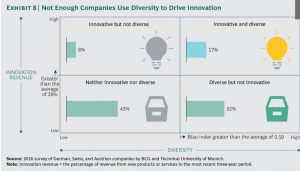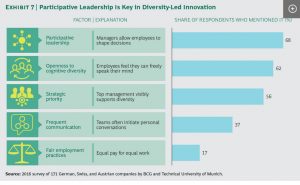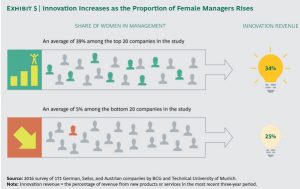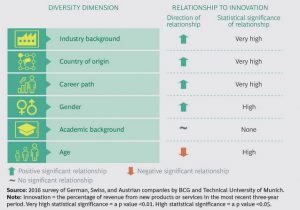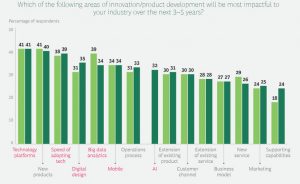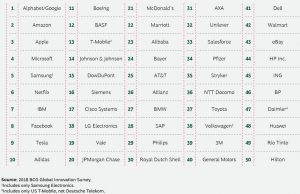Only one of Coca-Cola’s last six CEOs grew up in the United States. Deutsche Telekom set out to increase the representation of women in its management ranks in 2010, and now 40% of the people on its supervisory board are female. The Japanese beverage company Suntory didn’t promote an insider when it was looking for a new president to oversee a geographic expansion effort; it recruited the former chairman of Lawson, Japan’s second-largest convenience store chain.
When companies undertake efforts to make their management teams more diverse by adding women and people from other countries, industries, and companies, does it pay off? In the critical area of innovation, the answer seems to be yes. A study of 171 German, Swiss, and Austrian companies shows a clear relationship between the diversity of companies’ management teams and the revenues they get from innovative products and services. (See “Study Methodology.”)
The study comes at a time when diversity’s business benefits have become a topic of intense discussion. In the past, the indirect benefits of diversity were sufficient—an expansion of the job candidate pool at all levels, or an increase in social and political status for the company. Direct financial benefits weren’t needed to justify diversity initiatives—no one could even say for sure if such benefits existed. This study shows that they do.
BCG and the Technical University of Munich conducted an empirical analysis to understand the relationship between diversity in management (defined as all levels of management, not just executive management) and innovation. (See “How Diversity and Innovation Are Defined in This Report.”) Although the research is concentrated in a particular geographic region, we believe that its insights apply globally. The following are the major findings:
- The positive relationship between management diversity and innovation is statistically significant, meaning that companies with higher levels of diversity get more revenue from new products and services.
- The innovation boost isn’t limited to a single type of diversity. The presence of managers who are female or from other countries, industries, or companies can cause an increase in innovation.
- Management diversity seems to have a particularly positive effect on innovation at complex companies—those that have multiple product lines or that operate in multiple industry segments. Diversity’s impact also increases with company size.
- To reach its potential, gender diversity needs to go beyond tokenism. In our study, innovation performance only increased significantly when the workforce included a nontrivial percentage of women (more than 20%) in management positions. Having a high percentage of female employees doesn’t do anything for innovation, the study shows, if only a small number of women are managers.
- At companies with diverse management teams, openness to contributions from lower-level workers and an environment in which employees feel free to speak their minds are crucial in fostering innovation.
Five Work Environment Factors That Amplify Diversity’s Impact
Our study provides clear evidence that having a diverse management team is a valuable asset when it comes to innovation. But as with any valuable asset, it needs to be developed to reach its potential.
Diversity has the greatest impact on innovation at companies that reinforce diversity through five conditions in the work environment:
- Participative Leadership Behavior. When managers genuinely listen to employees’ suggestions and make use of them, diversity’s benefits multiply. Swarovski, the Austrian manufacturer of cut crystal, uses what it calls nudges to remind executives that their meetings will be more productive if attendees actively participate instead of deferring to those who are more senior. The nudges take different forms, including posters in hallways and whiteboard reminders in conference rooms.
- Openness to Cognitive Diversity. This describes a dynamic in which employees feel free to speak their minds. The German cable company Unitymedia, which participated in our survey, supports openness to cognitive diversity by encouraging opposing ideas and “constructive conflict,” in discussions both among peers and between employees and managers. A culture where change starts with a question, not a decision, “allows us to capture the potential of diversity,” an HR executive at Unitymedia told us in a follow-up interview.
- Strategic Priority. At some companies, diversity has considerable top management support. An example is France’s Airbus Group, whose Balance for Business initiative (aimed at increasing gender diversity at the largely male aeronautics company) has been endorsed by the top executive team, including the company’s CEO.
- Frequent Interpersonal Communication. When companies find ways to facilitate dialogue between people with different backgrounds, it can provide a creative spark and bolster innovation. Google does this through its cafés, which allow for spontaneous conversations among people who may have different educational, work, and national backgrounds, as well as vastly different levels of expertise.
- Equal Employment Practices. There’s nothing new or complicated about this concept, but it is still not universally implemented. Some companies are further ahead than others, however. The US apparel company Gap, for example, has won praise for eliminating the pay differences between its female and male employees. The apparel company’s commitment to gender diversity is also evident in the number of women on its senior leadership team and in the fact that a majority of its store managers are female.
By Rocío Lorenzo , Nicole Voigt , Karin Schetelig , Annika Zawadzki , Isabelle Welpe , and Prisca Brosi
More: www.bcg.com
